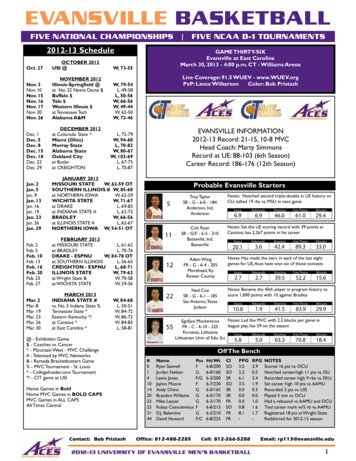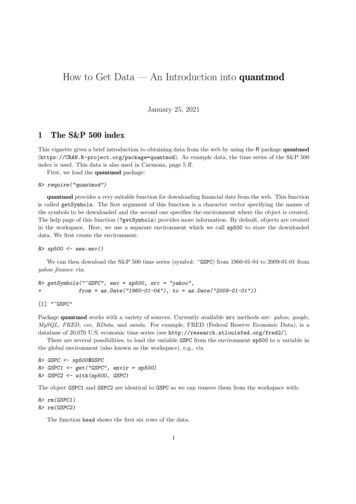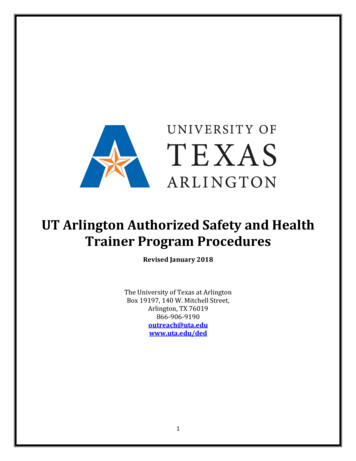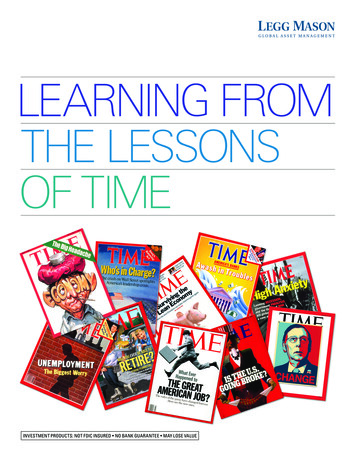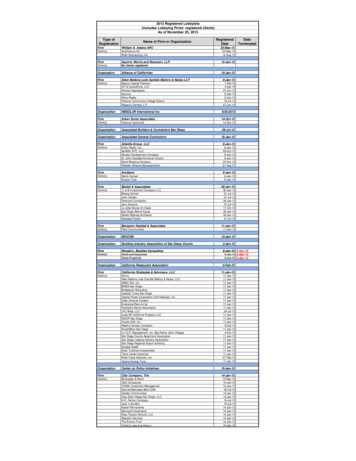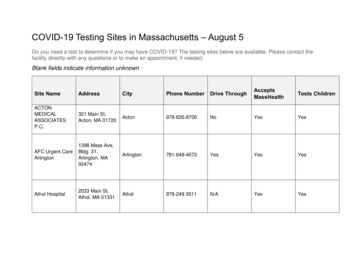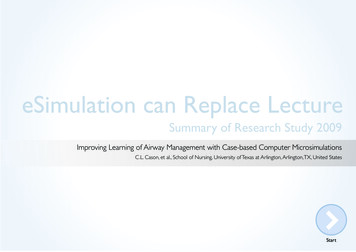
Transcription
Arlington, VAJan 25-30, 2017SUMMIT: Jan 31-Feb 1, 2017TRAINING:
SUMMIT:TRAINING:Jan 31 - Feb 1, 2017Jan 25-30, 2017LOCATION:Arlington, VAThe Cyber Threat Intelligence Summit & Training is back foranother year and it’s set to be bigger and better than ever!Check out what we have planned: Two Days of In-Depth Cyber Threat Intelligence Talks: The Summitfeatures two days packed with trending talks and leading speakers covering the mostinnovative CTI topics. Six World-Class SANS DFIR Courses: Prior to the two-day Summit, choosefrom six hands-on DFIR training courses taught by expert SANS instructors. Exclusive Networking Opportunities and Bonus Evening Sessions:Join your peers for an evening reception, DFIR NetWars, and SANS@Night talks.“One of very few events devoted solely to tradecraft of cyber threatanalysis and intelligence. Essential to both newcomers and seasonedpractitioners, and neither too fast nor too slow for either.”-PATTON ADAMS, VERISIGN IDEFENSESAVE200 when you register and pay forthe Summit by Dec 7th –Use code@sansforensics#CTISummitEarlyBird17REGISTER TODAY ATwww.sans.org/CTI-Summit
CTI TRAINING COURSESFOR578Cyber Threat IntelligenceFOR508Advanced Digital Forensics, IncidentResponse, and Threat Hunting GCFAFOR518Mac Forensic AnalysisFOR572Advanced Network Forensicsand Analysis GNFAFOR585Advanced Smartphone ForensicsGASFFOR610REM: Malware Analysis Toolsand Techniques GREMA L S O F E AT U R I N GSAVE400 Jan 28-29, 2017REGISTER TODAY ATwhen you register for theCyber Threat IntelligenceSummit and aSANS Course!www.sans.org/CTI-Summit
C T I S U M M I T K E Y N O T E P R E S E N TAT I O NClifford StollAuthor, Astronomer, SkepticClifford Stoll gained worldwide attention as a cyberspace sleuth when he wrotehis bestselling book, The Cuckoo’s Egg: Tracking a Spy Through the Maze of ComputerEspionage, the page-turning true story of how he caught a ring of hackers whostole secrets from military computer systems and sold them to the KGB. He hasbecome a leading authority on computer security. His lecture presentations areenergetic and entertaining, and showcase Clifford’s dry wit and penetrating views.Clifford Stoll is a commentator for MSNBC and an astronomer at the University ofCalifornia Berkeley.The Cuckoo’s Egg inspired a whole category of books on capturing computercriminals. He began by investigating a 75-cent error in time billing for the universitycomputer lab for which he was systems manager and ended up uncovering a ringof industrial espionage. Working for a year without support from his employersor the government, he eventually tracked the lead to a German spy hacking intoAmerican computer networks involved with national security and selling thesecrets to the KGB for money and cocaine.Since catching the “Hanover Hacker” (Hanover, West Germany), Stoll has become aleading expert on computer security and has given talks for both the CIA and theNational Security Agency, as well as the U.S. Senate.“With his analytical, scientific mindset – and no experience at all – Cliff Stoll uncoveredthe first documented case of espionage on what became the internet. This event iswhat grew into what we call Cyber Threat Intelligence today, and the methodology hefollowed is as applicable today as it was in 1986. Cliff is an amazing speaker and abrilliant mind, and a man we can all thank for our careers today.”-MIKE CLOPPERT, PRICEWATERHOUSECOOPERS, SENIOR CYBER THREAT ANALYST“If you’ve read ‘The Cuckoo’s Egg’ (and you should have), you know about the man whoengaged in the first-ever documented nation-state hacker hunt. Even decades later, CliffStoll’s story embodies so much of the mindset we need to successfully hunt attackers intoday’s networks. We can all learn something from Cliff’s story of meticulous attentionto logging data, breakthrough solutions to technical challenges, and working throughinternational bureaucracy to hunt the original APT.”-JAKE WILLIAMS, PRINCIPAL CONSULTANT, RENDITION SEC
C T I S U M M I T F E AT U R E D TA L K SHere’s a small sampling of the Cyber Threat Intelligence Summit talks.Integrating Cyber Threat Intelligence Using Classic Intel TechniquesService providers frequently limit the scope of CTI to the dissemination of threat feeds, third-party analysis,and indicators. As the cyber industry moves away from this limited understanding and begins to more clearlydefine CTI as a full-spectrum endeavor spanning tactical, operational, and strategic threat intelligence areas,it is important to illustrate how organizations can effectively incorporate actual CTI into their businessmodels. Through integration of the intelligence cycle into the cyber domain and appropriate tradecraft, thispresentation will examine how other organizations can incorporate this model. The audience will learn howto incorporate classic intelligence techniques into their cyber threat model to provide analysts and decisionmakers with actionable, predictive intelligence, and improved situational awareness. In addition, attendeeswill learn how integrating both tools and people (net defenders and cyber all-source analysts) within theirCTI model is imperative to create a holistic cyber-threat picture. To achieve this, we will use case studies tochallenge the notion that effective CTI is purely technical – it is not. Effective CTI is the marriage betweennet defense and all-source analysis.Elias Fox, Cyber Threat Intelligence Analyst- R&D, Noblis-NSPMariangela Taylor, Cyber Threat Intelligence Analyst- R&D, Noblis-NSPUsing CTI to Profile and Defend Against the World’s Most SuccessfulEmail ScamIn this talk, we will examine the various aspects of one of the world’s most successful email campaigns: thebusiness email scam. This campaign has stolen nearly 3.1 billion over the past three years, and shows nosigns of slowing down. This presentation will analyze research spanning over three years across the globeinvolving multiple case studies and banks from North Carolina to Hong Kong. We will start by examiningcharacteristics of the tools, context, and domains used by the attackers to trick companies. Using publiclyavailable and free tools, we will profile just how large this campaign is, what evidence is available, andhow to extract valuable indicators from the data. The presentation will conclude with lessons on how theattendees can use these publicly-available free tools to build profiles on attacks such as this scam. We willdiscuss how to take seemingly arbitrary indicators and use them to protect our networks and business. Lastly,we will also briefly discuss open source tools that smaller teams can use to maintain and organize theirindicators.Matt Bromiley, Senior Consultant, MandiantHunting Cyber Threat Actors with TLS CertificatesThis presentation will go over how net defenders and threat intel analysts can use TLS/SSL data from opensource sites like scans.io and censys.io to defend their networks and track threat actors that use TLS/SSLto encrypt their command and control, perform credential harvesting, or even manage their command andcontrol infrastructure.Most analysts know and use Whois registrant info to track domains threat actors create. However, a lot ofthreat actors have learned to use Domain Privacy Registration, which mitigates that tracking ability. Analystsalso like to use passive DNS sources to track domains and IPs as actors move their infrastructure. Othersanalysts use things like VirusTotal to track threat actors based off their malware, but not everyone hasaccess to VirusTotal. Using this technique, defenders and analysts can easily track malware command andcontrol infrastructure as it moves and put the appropriate defense mitigations in place as needed.Mark Parsons, DevOps/ThreatIntel, Punch Cyber AnalyticsTo view the entire Summit agenda, visit www.sans.org/CTI-Agenda
CTI SUMMIT SPEAKERSRob LeeMike CloppertSANS Instititute, SANS FellowPriceWaterhouseCoopers,Senior Cyber Threat AnalystSummit Advisory Board@robtlee@sansforensicsSummit Advisory Board@mikecloppertJuan Andrés Guerrero-SaadeRob DartnallTALK TITLE:TALK TITLE:Kaspersky Lab - GReAT,Senior Security ResearcherWave Your False Flags!Deception Tactics Muddying@juanandres gs Attribution in Targeted AttacksSecurity Alliance Ltd,Director of Cyber IntelligenceThe Use of ConventionalIntelligence Analysis Methodologies@cyberfusionteam in Cyber Threat IntelligenceBrian BartholomewElias FoxKaspersky Lab - GReAT,Senior Security ResearcheNoblis-NSP,Cyber Threat Intelligence AnalystTALK TITLE:@Mao WareTALK TITLE:Wave Your False Flags!Deception Tactics MuddyingAttribution in Targeted AttacksIntegrating Cyber ThreatIntelligence Using Classic IntelTechniquesMatt BromileyDave HerraldMandiant, Senior Consultant;SANS Institute, InstructorSplunk, Security ArchitectTALK TITLE:TALK TITLE:@505ForensicsUsing CTI to Profile and DefendAgainst the World’s MostSuccessful Email Scam@daveherraldRebekah BrownRick HollandRapid7,Threat Intelligence Lead;SANS Institute, InstructorSANS Institute, Summit Co-ChairTALK TITLE:Inglorious Threat IntelligenceSummit Advisory Board@PDXbek@agnuSergio CaltagironeJeremy JohnsonMicrosoft, Director,Threat Intelligence AnalysisFord Motor Company,Cyber Threat Intelligence AnalystTALK TITLE:@cnoanalysisThe Threat Intel Victory Garden:Creating, Capturing, and UsingYour Own Threat Intelligence UsingOpen-Source ToolsThreat Intelligence at Microsoft:A Look InsideTALK TITLE:@agnuUsing Intelligence to Heighten YourDefense Mobile ForensicsLincoln KaffenbergerIMF, Information Technology OfficerTALK TITLE:@LincolnKbergerLocation-Specific Cyber Risk:Where You Are Affects How BadlyYou’ll Be HackedRyan KovarSplunk Inc., Staff Security StrategistTALK TITLE:@meansecThe Threat Intel Victory Garden:Creating, Capturing, and UsingYour Own Threat Intelligence UsingOpen-Source Tools
CTI SUMMIT SPEAKERSJohn KupcinskiKPMG, DirectorTALK TITLE:Location-Specific Cyber Risk:Where You Are Affects HowBadly You’ll Be HackedRob M. LeeScott RobertsDragos, CEO;SANS Institute, Certified InstructorGitHub, Bad Guy Catcher;SANS Institute, InstructorTALK TITLE:@RobertMLeeKnowing When to ConsumeIntelligence vs. Generate ItSummit Advisory Board@srobertsKyle MaxwellAaron ShelmireVerisign iDefense, Senior ResearcherAnomali, Principal Threat ResearcherTALK TITLE:TALK TITLE:Effective Threat Intel ManagementAccurate Thinking: Analytic Pitfallsand How to Avoid Them@ashelmire@kylemaxwell@cyint dudeChristian ParedesMariangela TaylorBooz Allen Hamilton,Threat Intelligence AnalystNoblis-NSP, Principal Investigator/Cyber All-Source AnalystTALK TITLE:TALK TITLE:Pen-To-Paper and the FinishedReport: The (Often Overlooked) KeyTo Generating Threat IntelligenceIntegrating Cyber ThreatIntelligence Using Classic Intel@DaLastCenturion TechniquesRonnie TokazowskiMark ParsonsKing and Union,DevOps/ThreatIntelPhishMe, Senior ResearcherTALK TITLE:Reversing Threat Intelligence:Fun with Strings in MalwareHunting Cyber Threat Actors withTLS CertificatesTALK TITLE:@iHeartMalwareAlex PintoJake WilliamsNiddel, Chief Data ScientistRendition Infosec, Principal Consultant;SANS Institute, Certified InstructorTALK TITLE:@alexcpsecBeyond Matching:Applying Data-Science Techniquesto IOC-based DetectionSummit Advisory Board@MalwareJake
FOR578: Cyber Threat IntelligenceInstructors:Rebekah Brown @PDXBek Robert M. Lee @RobertMLeeDuring a targeted attack, an organization needs the best incident responseand hunting team in the field, poised to combat these threats and armedwith intelligence about how they operate. FOR578: Cyber Threat Intelligencewill train you and your team to respond to, detect, scope, and stopintrusions and data breaches.THERE IS NOTEACHERBUT THE ENEMY!“What is threat intelligence? When am I ready for it? How do I use it?This class answers these questions and more at a critical point in thedevelopment of the field of threat intelligence in the wider community.”-ROBERT M. LEE, FOR578 CO-AUTHORDetermine the role of cyber threat intelligence in your jobKnow when the analysis of an intrusion by a sophisticated actor is completeIdentify, extract, prioritize, and leverage intelligence from advanced persistent threat(APT) intrusionsExpand upon existing intelligence to build profiles of adversary groupsLeverage collected intelligence to be more successful in defending against andresponding to future intrusionsManage, share, and receive intelligence on APT actorswww.s a ns .o r g /CT I-FOR 5 7 8
FOR508: Advanced Incident Responseand Threat HuntingInstructor: Rob Lee @robtlee, @sansforensicsThis in-depth incident response course provides responders with advancedskills to hunt down, counter, and recover from a wide range of threatswithin enterprise networks, including APT adversaries, organized crimesyndicates, and hactivism.THE ADVANCEDPERSISTENTTHREAT IS INYOUR NETWORK –IT’S TIME TOGO HUNTING!“The most in-depth, state-of-the-art IR course I can imagine.It’s the first time I think defense can actually gain an advantage.”-KAI THOMSEN, AUDI AGLearn how to track advanced persistent threats in your enterprisePerform incident response on any remote enterprise systemExamine memory to discover active malwarePerform timeline analysis to track the steps of an attacker on your systemsDiscover unknown malware on any systemPerform deep-dive analysis to discover data hiddenby anti-forensicswww. sans . o r g / CT I-F OR 508www.giac.org/gcfa
FOR518: Mac Forensic AnalysisInstructor: Sarah Edwards @iamevltwinThis course aims to form a well-rounded investigator by introducing Macforensics into a Windows-based forensics world. The course focuses on topicssuch as the HFS file system, Mac-specific data files, tracking user activity,system configuration, analysis and correlation of Mac logs, Mac applications,and Mac-exclusive technologies. A computer forensic analyst who successfullycompletes the course will have the skills needed totake on a Mac forensics case.FORENSICATEDIFFERENTLY!“The most comprehensive Mac class I’ve taken.”-DANIEL MILLS, NASAAnalyze and parse the Hierarchical File System (HFS ) file system by hand andrecognize the specific domains of the logical file system and Mac-specific file typesUnderstand and profile users through their data files and preference configurations.Determine how a system has been used or compromised by using the system anduser data files in correlation with system log files.Understand and analyze many Mac-specific technologies, including Time Machine,Spotlight, iCloud, Versions, FileVault, AirDrop, and FaceTime.www. sans . o r g / CT I-F OR 518
FOR572: Advanced Network Forensicsand AnalysisInstructor: Ryan Johnson @ForensicRJThis course was built from the ground up to cover the most critical skillsneeded to mount efficient and effective incident response investigations.We focus on the knowledge necessary to expand the forensic mindset fromresidual data on the storage media from a system or device to the transientcommunications that occurred in the past or continue to occur.BAD GUYS ARETALKING– WE’LL TEACHYOU TO LISTEN“I research ICS/SCADA environments. I think FOR572presents a better approach at detecting malwarethan a more traditional approach does.”-NIKLAS VILHELM, NORWEGIAN NATIONAL SECURITY AUTHORITYExtract files from network packet captures and proxy cache filesUse historical NetFlow data to identify relevant past network occurrencesReverse engineer custom network protocolsDecrypt captured SSL traffic to identify attackers actionsIncorporate log data into a comprehensive analytic processLearn how attackers leverage man-in-the-middle toolsAnalyze network protocols and wireless network trafficw w w. sans.or g/CTI-FOR572www.giac.org/gnfa
FOR585: Advanced Smartphone ForensicsInstructor: Cindy Murphy @cindymurphMobile devices are often a key factor in criminal cases, intrusions, IP theft,security threats, and more. Understanding how to leverage the data from thedevice in a correct manner can make or break your case and your futureas an expert. FOR585: Advanced Smartphone Forensicswill teach you those skills.SMARTPHONEDATA CAN’T HIDEFOREVER –IT’S TIME TOOUTSMART THEMOBILE DEVICE!“FOR585 provides forensics with the mentality and set of toolsrequired to forensically examine most types of devices.”-STEVE BONE, MODSelect the most effective forensic tools, techniques, and procedures for criticalanalysis of smartphone dataReconstruct events surrounding a crime using information from smartphones,including timeline development and link analysis (e.g., who communicated withwhom, where, and when)Understand how smartphone file systems store data, how theydiffer, and how the evidence will be stored on each deviceInterpret file systems on smartphones and locate informationthat is not generally accessible to usersw w w. sans.or g/CTI-FOR585www.giac.org/gasf
FOR610: REM: Malware Analysis Toolsand TechniquesInstructor: Lenny Zeltser @lennyzeltserThis popular malware analysis course has helped forensic investigatorsand incident responders acquire practical skills for examining maliciousprograms that target Microsoft Windows. This training also teaches how toreverse-engineer web browser malware implemented in JavaScript, as well asmalicious documents such as PDF and Microsoft Office files.TURNMALWAREINSIDE OUT“FOR610 should be required training for all forensic investigators.It is necessary for awareness, analysis, and reporting of threats.”-PAUL GUNNERSON, U.S. ARMYBuild an isolated lab for analyzing malicious codeEmploy network and system-monitoring tools for malware analysisExamine malicious JavaScript and VB ScriptUse a disassembler and debugger to analyze malicious Windows executablesBypass a variety of defensive mechanisms designed by malware authorsDerive Indicators of Compromise (IOCs) from malicious executablesUtilize practical memory forensics techniques tounderstand malware capabilitiesw w w. s a n s . o r g / C T I - F O R 6 1 0www.giac.org/grem
SANS CTI INSTRUCTORSRebekah Brown SANS InstructorRebekah Brown is the threat intelligence lead for Rapid7, supporting incident response, analyticresponse, global services and product support. She is a former NSA network warfare analyst,U.S. Cyber Command training and exercise lead, and Marine Corps crypto-linguist who hashelped develop threat intelligence programs at the federal, state, and local levels as well as inthe private sector at a Fortune 500 company. She has an Associates in Chinese Mandarin, aB.A. in International Relations, and is wrapping up a M.A in Homeland Security with a Cybersecurity focus and agraduate certificate in intelligence analysis. @PDXBekSarah Edwards Certified InstructorA self-described Mac nerd, Sarah Edwards is a forensic analyst, author, speaker, and bothauthor and instructor of SANS FOR518: Mac Forensic Analysis. She has been a devoted user ofApple devices for many years and has worked specifically in Mac forensics since 2004, carvingout a niche for herself when this area of forensics was still new. Although Sarah appreciatesdigital forensics in all platforms, she has a passion for working within Apple environmentsand is well known for her work with cutting-edge Mac OS X and iOS, and for her forensic file system expertise.Sarah has more than 12 years of experience in digital forensics, and her passion for teaching is fueled by theever-increasing presence of Mac devices in today’s digital forensic investigations. Sarah has worked with federallaw enforcement agencies on a variety of high-profile investigations in such areas as computer intrusions, criminalcases, counter-intelligence, counter-narcotics, and counter-terrorism. Her research and analytical interests includeMac forensics, mobile device forensics, digital profiling, and malware reverse engineering. @iamevltwinRyan Johnson SANS InstructorRyan Johnson is the Head of CSIRT Readiness and Investigations at PricewaterhouseCoopers.In this role, Ryan is responsible for global CSIRT readiness, insider threat, and strategicthreat intelligence. Previously, Ryan was a Senior Director and lead incident responder inthe Cyber Division of consulting firm Alvarez & Marsal. Ryan has been investigating crimesin the digital realm for more than 12 years including performing media exploitation forthe U.S. Army in Iraq. Ryan has run multiple large-scale breach investigations and has also provided clients withproactive assessments that assisted them in identifying both security gaps, and identifying systems which arealready compromised. Ryan taught digital forensics for the US State Department’s Anti-Terrorism Assistance programand was a co-author of several of their digital forensics courses. Ryan also co-authored Mastering WindowsNetwork Forensics and Investigations, Second Edition. Ryan’s industry credentials include: GIAC Network ForensicAnalyst (GNFA), GIAC Continuous Monitoring Certification (GMON), GIAC Certified Incident Handler (GCIH), CertifiedInformation System Security Professional (CISSP), Certified Forensic Computer Examiner (CFCE), Digital ForensicsCertified Professional (DFCP), EnCase Certified Examiner (EnCE), and Payment Card Industry Professional (PCIP). Hehas earned an M.S. from Dalhousie University and two Bachelor’s degrees from Queen’s University. @ForensicRJRobert M. Lee Certified InstructorRobert M. Lee is the CEO and Founder of Dragos Security LLC, a critical infrastructurecybersecurity company, where he pursues his passion for control system traffic analysis,incident response, and threat intelligence research. Rob is the course author of SANS ICS515:ICS Active Defense and Incident Response, and the co-author of SANS FOR578: Cyber ThreatIntelligence. He is also a non-resident National Cyber Security Fellow at New America focusingon policy issues relating to the cybersecurity of critical infrastructure, and a PhD candidate at Kings CollegeLondon. For his research and focus areas, he was named one of Passcode’s Influencers and awarded EnergySec’s2015 Cyber Security Professional of the Year. Rob was also named to the 2016 class of Forbes “30 Under 30”for Enterprise Technology as one of “the brightest entrepreneurs, breakout talents, and change agents” in thesector. Robert obtained his start in cybersecurity serving as a Cyber Warfare Operations Officer in the U.S. AirForce. He has performed defense, intelligence, and attack missions in various government organizations includingthe establishment of a first-of-its-kind ICS/SCADA cyber threat intelligence and intrusion analysis mission. Robertroutinely writes articles in publications such as Control Engineering and the Christian Science Monitor’s Passcodeand speaks at conferences around the world. Lastly, Robert, is author of the book “SCADA and Me” and the weeklyweb-comic Little Bobby (www.littlebobbycomic.com). @RobertMLee
SANS CTI INSTRUCTORSRob Lee Faculty FellowRob Lee is an entrepreneur and consultant in the Boston area, specializing in informationsecurity, incident response, threat hunting, and digital forensics. Rob is currently the curriculumlead and author for digital forensic and incident response training at the SANS Institutein addition to owning his own firm. Rob has more than 18 years of experience in digitalforensics, vulnerability and exploit discovery, intrusion detection/prevention, and incidentresponse. Rob graduated from the U.S. Air Force Academy and served in the U.S. Air Force as a founding memberof the 609th Information Warfare Squadron, the first U.S. military operational unit focused on informationoperations. Later, he was a member of the Air Force Office of Special Investigations (AFOSI) where he led ateam conducting computer crime investigations, incident response, and computer forensics. Prior to starting hisown firm, he directly worked with a variety of government agencies, U.S. Department of Defense, and intelligencecommunities as the technical lead for a vulnerability discovery and an exploit development team, lead for a cyberforensics branch, and lead for a digital forensic and security software development team. Rob was also a directorfor MANDIANT, a company focused on investigating advanced adversaries, such as the APT, for five years prior tostarting his own business. Rob co-authored the book Know Your Enemy, 2nd Edition. Rob earned his MBA fromGeorgetown University in Washington DC. Rob is also a co-author of the MANDIANT threat intelligence reportM-Trends: The Advanced Persistent Threat. @robtlee, @sansforensicsCindy Murphy Certified InstructorCindy Murphy served in law enforcement for more than 30 years, including 24 years as adetective with the Madison Police Department in Wisconsin. During 17 of those years sheworked as a certified digital forensics examiner. During her time as an investigator, she sawfirsthand the emergence of mobile devices as the primary source of evidence in investigations.This pushed her to grow into the mobile forensics expert she is today and enabled her to coauthor the SANS FOR585 Advanced Smartphone Forensics course. Just recently, Cindy took a leave of absence fromthe Madison Police Department to launch Gillware Digital Forensics, where she is co-owner and serves as presidentand lead examiner. As a life-long police officer, Cindy knows the transition from the public to the private sectorto private will present new challenges, but she’s looking forward to broadening her professional experience evenfurther, which will benefit both Cindy and her students. @cindymurphLenny Zeltser Senior InstructorLenny Zeltser is a seasoned business and tech leader with extensive information securityexpertise. As a product portfolio owner at NCR, he delivers the financial success and expansionof the company’s security services and SaaS products. Beforehand, as the national lead of thesecurity consulting practice at Savvis (acquired by CenturyLink), he managed the US team ofservice professionals, aligning their expertise to the firm’s cloud solutions. Lenny helped shapeglobal infosec practices by teaching incident response and malware defenses at SANS Institute and by sharingknowledge through writing, public speaking and community projects. Lenny has earned the prestigious GIACSecurity Expert professional designation and developed the Linux toolkit used by malware analysts throughoutthe world. His approaches to business and technology are built upon work experience, independent research, aComputer Science degree from the University of Pennsylvania and an MBA degree from MIT Sloan. Lenny’s expertiseis strongest at the intersection of business, technology and information security and spans incident response,infosec cloud services and business strategy. To get a sense for his thought process and knowledge areas, take alook at his blog at https://zeltser.com. @lennyzeltser
Are you one of the topDigital Forensics & Incident Response Professionals?2 Nights of DFIR NetWars atSANS CTI SUMMIT 2017!SAT, JAN 28 - SUN, JAN 29Come and join us for this excitingevent to test your skills in achallenging and fun learningenvironment. Registration for DFIRNetWars is FREE OF CHARGETO ALL STUDENTS AT SANSCTI SUMMIT 2016. Externalparticipants are welcome to join foran entry fee of 1,520.6:30-9:30 PMSANS DFIR NetWars Tournament is anincident simulator packed with a vastamount of forensic and incident responsechallenges for individual or team-based“firefights.” It is developed by incidentresponders and forensic analysts who usethese skills daily to stop data breachesand solve complex crimes. DFIRNetWars Tournament allows each playerto progress through multiple skill levelsof increasing difficulty, learning first-handhow to solve key challenges they mightexperience during a serious incident.DFIR NetWars Tournament enablesplayers to learn and sharpen new skillsprior to being involved in a real incident.www.sans.org/CTI-SummitALSO CHECK OUT
S A N S @ N I G H T E V E N I N G TA L K SEnrich your SANS training experience!Evening talks by our instructors and selected subject-matter expertshelp you broaden your knowledge, hear from the voices that matter incomputer security, and get the most for your training dollar.KEYNOTE:Intel All the Things! 2016 a Year in ReviewRobert M. LeeThis past year saw a host of new companies, methodologies,and case studies in the cyber threat intelligence community.Some were exciting (first cyber attack leading to outagesin a power grid), some were entertaining (Guccifer and theDemocratic National Convention), and some were a mixof both (Norse anyone?). This presentation will give a noholds-barred look at 2016, including all of the pitfalls andopportunities, as we hit 2017 running. The community isgetting larger and as such it is more critical than ever toextract the right lessons learned to move forward.iOS Location ForensicsSarah EdwardsIt is no secret iOS devices can track a user’s every move,providing location data that can be a major factor in manytypes of investigations. This valuable information can befound in a variety of areas on the iOS device. In this webcast,we will walk you through native iOS databases, plist files,and third-party applications where this information is keptand tracked. We will also introduce you to scripts createdto make data analysis easier by allowing you to do fast-datacorrelation and build a historical map of ontinuous
FOUNDING PARTNERAPRIL 18-25, 2017 NEW ORLEANSSAVE THE DATE!www.sans.org/ThreatHuntingWill you be the Hunter or the Prey?SAVE THE DATE!SUMMIT & TRAININGJUNE 22-29, 2017 AUSTIN, TXwww.sans.org/dfirsummit
Hotel InformationTraining CampusRenaissance ArlingtonCapital View Hotel2800 South Potomac AveArlington, VA 22202703-413-1300www.sans.org/cti-locationSpecial Hotel Rates AvailableTop 5 reasons to stay at RenaissanceArlington Capital View HotelA special discounted rate of 174.00 S/Dwill be honored until January 3, 2017based on space availability.1 All SANS attendees receive complimentaryhigh-speed Internet wh
Splunk, Security Architect TALK TITLE: The Threat Intel Victory Garden: Creating, Capturing, and Using Your Own Threat Intelligence Using @daveherrald Open-Source Tools Sergio Caltagirone Microsoft, Director, Threat Intelligence Analysis TALK TITLE: Threat Intelligence at Microsoft: A Look Inside @cnoanalysis Brian Bartholomew Kaspersky Lab .
